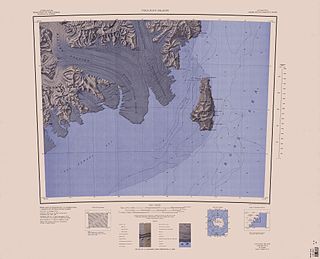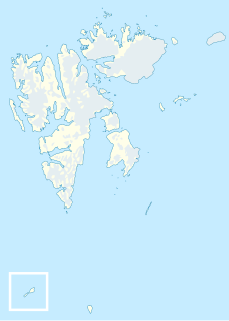
The Arctic Archipelago, also known as the Canadian Arctic Archipelago, is a group of islands north of the Canadian mainland.

The Balearic Sea is a body of water in the Mediterranean Sea near the Balearic Islands. It is not to be confused with the Alboran Sea or the Iberian shelf waters. The Ebro River flows into this small sea.

The Moluccan Sea is located in the western Pacific Ocean, around the vicinity of Indonesia, specifically bordered by the Indonesian Islands of Celebes (Sulawesi) to the west, Halmahera to the east, and the Sula Islands to the south. The Molucca Sea has a total surface area of 77,000 square miles. The Molucca Sea is rich in coral and has many diving sites due to the deepness of its waters. The deepness of the water explains the reasoning behind dividing the sea into three zones, which functions to transport water from the Pacific Ocean to the shallower seas surrounding it. The deepest hollow in the Molucca Sea is the 15,780-foot (4,810-meter) Batjan basin. This region is known for its periodic experiences of earthquakes, which stems from the sea itself being a micro plate, in which the Molucca Sea is being subducted in two opposite directions: one in the direction of the Eurasian Plate to the west and the other in the direction of the Philippines Sea Plate to the east.

Ross Archipelago is a name for that group of islands which, together with the ice shelf between them, forms the eastern and southern boundaries of McMurdo Sound in Antarctica. The most northerly is Beaufort Island, then comes Ross Island, the Dellbridge Islands, and Black Island and White Island. Frank Debenham's classic report, The Physiography of the Ross Archipelago, 1923, described "Brown Island" as a part of the group.

Mariner Glacier is a major glacier over 100 km (62 mi) long, descending southeast from the plateau of Victoria Land, between Mountaineer Range and Malta Plateau, and terminating at Lady Newnes Bay, Ross Sea, where it forms the floating Mariner Glacier Tongue. Its lower reaches and entrance to its valley were reconnoitered in December 1958 by Captain John Cadwalader, US Navy, and two members of New Zealand Geological Survey Antarctic Expedition (NZGSAE), in a flight from the icebreakers USS Glacier and USS Staten Island which were lying close off the south end of Coulman Island, in an attempt to land expedition members on the mainland. Named by NZGSAE, 1958–59, as a tribute to the work of mariners in Antarctic research and exploration.
The Helo Cliffs are a set of prominent cliffs at about 3,525 metres (11,565 ft) on the north rim of the summit caldera of Mount Erebus, on Ross Island, Antarctica. The name derives from a nearby U.S. Coast Guard HH-52A helicopter which crashed on the east slope of Mount Erebus while en route to Cape Bird from McMurdo Station on January 9, 1971. The helicopter lost power in flight and was damaged when it landed. The four crew and passengers were not injured. The helicopter was abandoned because of its location.

Aurora Glacier is a large glacier draining that part of Ross Island between Mount Erebus and Mount Terra Nova, and flowing south into McMurdo Ice Shelf. It was named by A.J. Heine in 1963 after the Aurora, the ship of the Ross Sea Party of the British expedition under Ernest Shackleton, 1914–17.

Menkeøyane is a small Norwegian island group south of Halvmåneøya, an island off the southeast coast of Edgeøya. The group includes Havella, Alka, Gassen, Teisten, Islomen and Blåmåken. They comprise part of Thousand Islands. The islands are named after the German cartographer and historical geographer Heinrich Theodor Menke (1819–92). The islands appear on the Muscovy Company's map (1625), one of which is labeled Heling I.

Bölscheøya is an island southwest of Negerpynten, the southeastern point of Edgeøya. It is part of Thousand Islands. The island was named in 1868 by the German geographer August Petermann (1822–78) after the German journalist Carl Bölsche, father of the German writer and zoologist Wilhelm Bölsche (1843–93). The remains of a whaling station from the 17th century can be found on the island.

Meinickeøyane is an island group composed of two islets, Store Meinickeøya and Vesle Meinickeøya, that form part of Thousand Islands, an island group south of Edgeøya, part of the Svalbard archipelago. They were named after the German geographer Carl Eduard Meinicke (1803–76).
Arendtsøya is a small island in Kong Ludvigøyane, part of Thousand Islands, an island group south of Edgeøya. The island is named after the German geographer Karl Arendts (1815–81).
The Findlay Group is a group of islands in the Canadian Arctic Archipelago in Qikiqtaaluk Region, Nunavut. This Arctic Ocean group consists of Lougheed Island, Stupart Island, Edmund Walker Island, Grosvenor Island and Patterson Island.

Erebus Glacier is a glacier draining the lower southern slopes of Mount Erebus, Ross Island, Antarctica. It flows west to Erebus Bay where it forms the floating Erebus Glacier Tongue. It was named in association with Mount Erebus by the British National Antarctic Expedition, 1901–04, under Robert Falcon Scott.
Hidaybu District is one of two districts of the Socotra Governorate, Yemen. It occupies the eastern part of the main island of Socotra archipelago. It is named after its capital and the principal town of the archipelago, the town of Hidaybu (Hadibu). As of 2003, the district had a population of 34,011 people.
Fang Glacier is a glacier on the west side of Fang Ridge, separating the old and new craters of Mount Erebus on Ross Island. It was charted by Frank Debenham of the British Antarctic Expedition, 1910–13, and named by him in association with Fang Ridge.
Millennium Peak is a peak rising to about 1,800 metres (6,000 ft) on the northeast slope of Mount Erebus, Ross Island, Antarctica, 4 nautical miles (7 km) east-northeast of the Erebus summit. It was so named by the Advisory Committee on Antarctic Names in the millennium year 2000.
Mount Terra Nova is a snow-covered mountain, 2,130 m (6,990 ft), between Mount Erebus and Mount Terror on Ross Island. First mapped by the Discovery expedition 1901-04, and named for Terra Nova, relief ship for this expedition and the British Antarctic Expedition, 1910-13.









